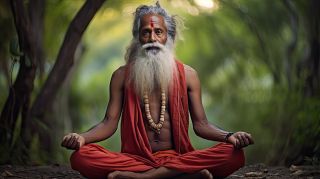Spirituality
The First-Ever Mention and Definition of Yoga
The earliest exposition of yoga is by Yama, the Hindu god of death.
Updated May 7, 2024 Reviewed by Michelle Quirk
Key points
- The first-ever mention of yoga as a form of spiritual practice dates to the early centuries BCE.
- In the Katha Upanishad, Yama, the god of death, reveals the secret of the self to an insistent boy.
- For Yama, knowledge of the self can only be attained through the practice of yoga.

Yoga is practised in the West as a form of physical culture, with postures borrowed from Hatha Yoga and optional spiritual sprinklings for stress relief.
In this new series, I will explore the true, historical meaning of yoga—starting with the first-ever mention and definition of yoga as a form of spiritual practice.
The Story of Nachiketa
The story of the brahmin boy Nachiketa is told in the Katha Upanishad, which dates to around the fourth century BCE.
The brahmin (priest) Vajashravasa purports to be sacrificing everything he owns, but his son Nachiketa notices that he is only bringing out those cows that are old, lame, or otherwise unproductive.
Nachiketa repeatedly taunts his father, saying, “I too am yours! To which god will you offer me?” In a fit of rage, Vajashravasa cries out, “To Yama himself!”
Taking his father at his word, Nachiketa descends to Yama’s deathly abode. But Yama is out, and the boy is made to wait for three days without food or water. When Yama returns, he offers the brahmin boy three boons to atone for his lack of hospitality.
Nachiketa’s Three Requests
For the first boon, Nachiketa asks for peace between himself and his father when he is returned to the old man. Yama happily grants this.
For the second boon, he asks to learn the fire sacrifice, which he performs to Yama’s satisfaction.
Finally, for the third boon, he asks to be told what comes after death.
At this, Yama replies:
Here, even the gods of yore had doubt. Indeed it is not easy to know—subtle is this matter—Oh, Nachiteka, ask for some other boon. Press not this on me; give this up for me … ask for centenarian sons and grandsons, many cattle, elephants, gold and horses. Ask for wide extent of earth and live yourself, as many autumns as you like.
But Nachiketa remains unswayed by the riches of the world, saying that man is not to be satisfied with wealth: “If wealth were wanted, we shall get it, if we only see thee.”
The Secret of the Self
Impressed and flattered by the boy, Yama agrees to tell him the secret of the self (Atman), which persists beyond the death of the body.
Many people choose the path of what is pleasant, but happiness comes only to those who choose the path of what is good:
Living in the middle of ignorance and regarding themselves as intelligent and learned, the ignorant go round and round, in many crooked ways, like the blind led by the blind.
The knowledge of Atman cannot be reached by study, reason, or intelligence, but only by a pure, searching mind, such as that of Nachiketa.
Knowledge of the self can only be attained through the practice of Yoga, which Yama defines for Nachiketa as “the firm holding back of the senses”:
When the five organs of perception become still, together with the mind, and the intellect ceases to be active: that is called the highest state.
This is the first ever mention of “yoga” in its modern sense, and it is by Death himself!
Yama warns Nachiketa to be watchful, “for Yoga comes and goes.”
Nachiketa bids farewell to Yama and returns to his father as a jivanmukta—that is, one who has achieved liberation (moksha) in the course of this life.
Read more in Indian Mythology and Philosophy
References
Yoga defined as "the firm holding back of the senses": Katha Upanishad 2.3.10–11.


